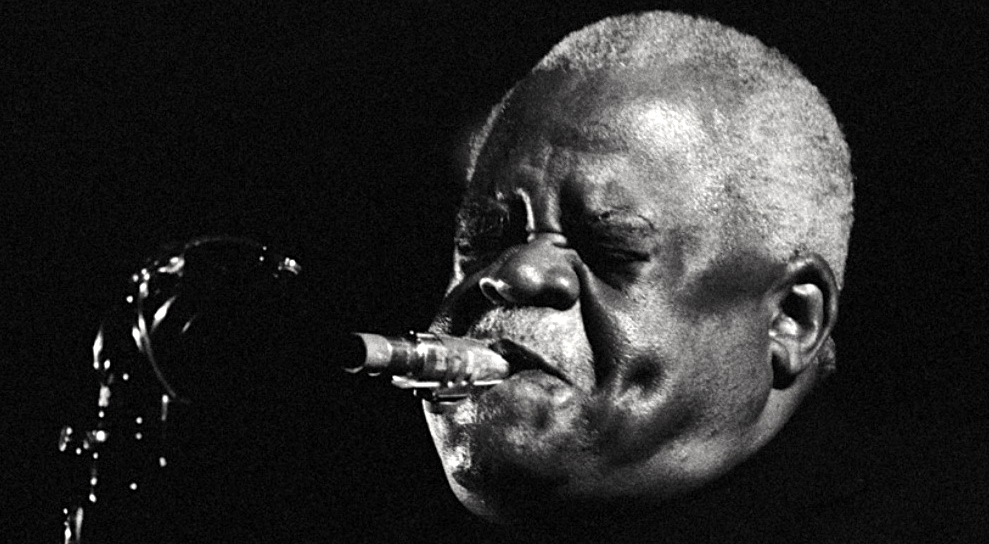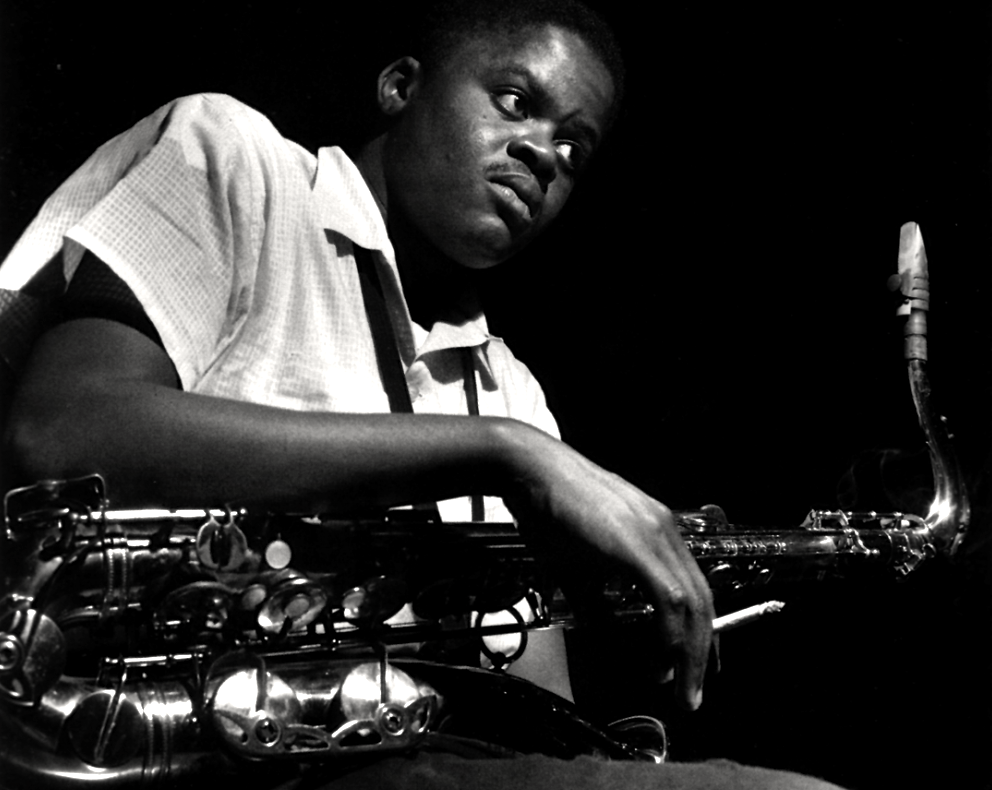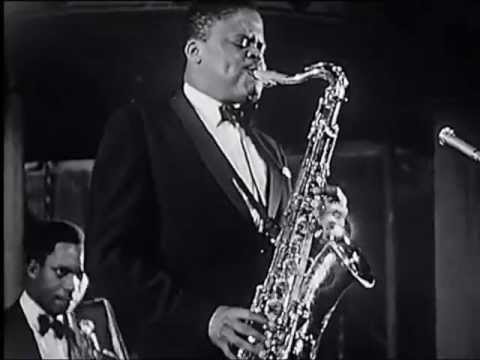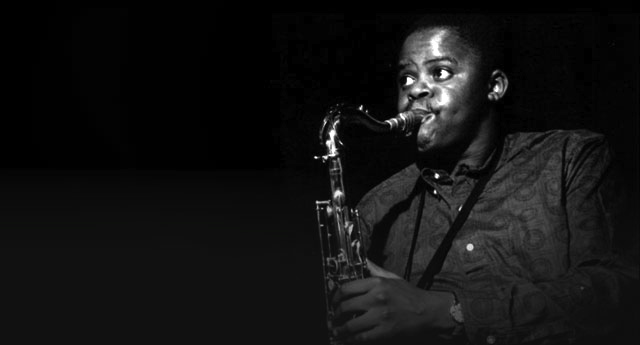
Stanley William Turrentine (tenor saxophonist) was born on April 5, 1934 in Pittsburgh, Pennsylvania and passed away on September 12, 2000 in New York City.
Stanley came out of a musical family in Pittsburgh, his father Thomas played sax in Al Cooper’s Savoy Sultans in the 1930s, and he was Stanley’s first teacher when the boy took up the tenor sax at age 13.
Stanley credited his mother, a piano teacher, with instilling in him the bluesy feel he brought out so distinctively in his music. His brother, Tommy, six years his elder, was a trumpeter and underrated composer who served stints in the big bands of Billy Eckstine, Dizzy Gillespie, Count Basie and Benny Carter. He gave Stanley his first job at age 16 in one of the small groups he led in Pittsburgh.
Upon graduating from high school in 1951, Stanley joined the Lowell Fulson band, which then included a young Ray Charles, who Turrentine considered a great influence. Turrentine left the Fulson band to join Charles’s first band. In 1953, Turrentine moved to Cleveland with brother Tommy to work in Tadd Dameron’s group. The following year, Stanley replaced John Coltrane in Earl Bostic’s group, and brother Tommy joined several weeks later. Stanley then joined the army where he played in the 158th Army Band, known as “Uncle Sam’s All Stars.”
In March of 1959, Stanley joined Tommy once again in drummer Max Roach’s quintet, where the pair began to attract attention. While his major influences – Don Byas, Ben Webster, Illinois Jacquet, Lester Young, Coleman Hawkins and Sonny Rollins – can all be heard in his playing, there was no mistaking him for anyone else when he started to wail.

This edition of the Max Roach Quintet, in its fourteen months together, made many recordings under Roach’s name, a date for Roach’s then-wife Abbey Lincoln, and the solo recording debuts on Time Records: Stan “The Man” Turrentine and Tommy Turrentine, respectively.
Stanley’s prominence in the Max Roach group brought him to the attention of Blue Note’s Alfred Lion, who was immediately drawn to Stanley’s ability to blend a big, soulful tenor sound with contemporary jazz concepts. Lion brought Turrentine to Blue Note in 1960, and immediately set about a dizzying spell of recordings, starting with two exceptionally fine Jimmy Smith sets in 1960, Midnight Special and Back At The Chicken Shack in 1960.
Turrentine recorded the first of his many albums as a leader for Blue Note, Look Out!, in1960. This debut featured the tenor player fronting pianist Horace Parlan’s magnificent trio, with George Tucker on bass and Al Harewood on drums. This memorable lineup can be heard on the track “Someone to Watch Over Me.”
Parlan and Turrentine had known each other since high school days in Pittsburgh, and the two made a potent musical team, brimming with a distinctive energy. They went on to record Up At “Minton’s” with Grant Green, and Comin’ Your Way with Tommy Turrentine, which was intended to be Stanley’s third album for Blue Note, but was not issued until the 1970s.

The pair can also be heard two of Parlan’s Blue Note albums Speakin’ My Piece and On The Spur Of The Moment. There are many fine performances on these albums, where all concerned dig deep into a bluesy bag of bop and gospel grooves: “Minor Chant” from Look Out!, “Thomasville” from Comin’ Your Way and “Stanley’s Time,” “Broadway,” “Later At Minton’s,” and “Come Rain Or Come Shine,” from Up At “Minton’s”.
Blue Note placed Turrentine in many interesting and ultimately satisfying settings, and he recorded prolifically, notably on Blue Hour from1960 with The Three Sounds. Also not to miss are Turrentine’s second Blue Note album from 1962, That’s Where It’s At with Les McCann, Jubilee Shout!!!, with Kenny Burrell and Sonny Clarke, also recorded in 1962 but first issued in 1978, guitarist Kenny Burrell’s superior album Midnight Blue from 1963, and Easy Walker with McCoy Tyner in 1966.
But it was organist Shirley Scott, also Turrentine’s wife at this time, who was his most formidable musical partner. The pair recorded 14 albums between 1961 and 1968 for the Blue Note, Prestige, Impulse! and Atlantic labels. Six of these appeared under his name, such as the 1968 album for Blue Note Common Touch, which includes the track “Buster Brown.”
Turrentine is in particularly fine form on these recordings. Indeed, one could argue, they capture the quintessence of his style, and the way audiences heard him live during the 1960s. It’s very clear that as musicians, the pair shared a special rapport. Turrentine, at home in most any environment, was extremely well-suited to Ms. Scott’s deft, lightly orchestral touch on organ as well as she was to Turrentine’s finely-woven, soulfully integrated story-like lines.
The best of these recordings, Let It Go for Impulse in 1966, is a perfect mix of bluesy, and gospel-tinged originals. The title track is an early imprint for Turrentine’s later hit “Sugar,” and the balance of the cuts are soulful standards and unfailingly foot-tapping takes on current pop hits.

On every one of his albums with Scott, Turrentine’s bluesy originals are the highlights: the rip-roaring “Soul Shoutin’” from the album of the same name, the after-hours glow of “The Soul Is Willing,” also a title track, the swinging minor-key blues, “The Hustler” from Hustlin’ and the seductive Latinate “Shirley” from Everybody Loves A Lover. Their covers are almost always worth hearing too: “Trouble,” released on both Never Let Me Go and Hustlin’, “Grand Street” from Blue Flames, “God Bless The Child” from Never Let Me Go, “Sent For You Yesterday” from Everybody Loves A Lover and even Bob Dylan’s “Blowin’ In The Wind” on both Common Touch and Soul Song.
As the 1960s progressed, Turrentine recorded in other Blue Note ensembles, mostly in larger settings arranged by Oliver Nelson, such as Joyride from 1965, Duke Pearson’s Rough ‘N’ Tumble and The Spoiler in 1966; A Bluish Bag, and The Return Of The Prodigal Son in 1967. He can also be heard on Thad Jones’s The Look Of Love from 1968, Always Something There from 1968 and a final quintet session Another Story, from 1969 with Thad Jones and Cedar Walton.
Turrentine signed on to Creed Taylor’s newly independent CTI label in 1970 and scored their very first hit with “Sugar,” a modal minor-key blues which first paired him with another former Blue Note star, Freddie Hubbard. “The Sugar Man,” as Turrentine became known in the wake of this success, and Hubbard played together often in the early 1970s, as part of each other’s groups and as part of the CTI All Stars, which began tours in 1971.
CTI afforded Turrentine a great deal of artistic freedom, and provided him with first-call players and featured him in more classy settings. No longer a marginalized chitlin circuit player, he was now a jazz star, recording for the decade’s premier label. Turrentine headlined six albums for the label between 1970 and 1973, and can also be heard on an album of outtakes and five all-star sessions. These include Cherry from 1972 with Milt Jackson, and the magnificent Don’t Mess With Mister T. from 1973, his next hit, which featured contributions and superlative arrangements from Bob James. The title song, from Marvin Gaye’s score to the film Trouble Man, earned him his most enduring nickname, Mister T., years before it was usurped by the gold chain-loving actor.
Seeking greater flexibility in his career, Turrentine switched to the Fantasy label in 1974 and immediately scored his next radio hit with Michel Legrand’s “Pieces of Dreams,” the title theme to a 1970 film. But even though the tenor player had finally earned full control of his music, most of the eight albums he recorded for Fantasy through 1980 were overly orchestrated by either Gene Page or Wade Marcus, and more commercial than anything he did while with CTI.
Turrentine’s playing is never less than interesting, but neither he nor his settings during this period rise above the merely listenable. Notable exceptions include the outstanding 1977 albums Nightwings and West Side Highway albums, which paired him with arranger Claus Ogerman and a large group of New York’s first-rate studio session stars. Listeners can only imagine what a master recordist like Rudy Van Gelder might have made of the talent on these sessions.
Turrentine’s subsequent switch to Elektra Records hardly improved matters, as they heralded his turn towards pop music from jazz. “I just want lots of people to hear my music,” Turrentine said at the time. “I want to make records that will sell – to everybody.”
urrentine recorded four interesting, if rather unremarkable, albums for the label between 1979 and 1982, increasingly allowing the production to take over. The second of these,Inflation from 1980, is perhaps the best, providing two decent Turrentine originals, the title track and “Is It You,” and some rather good interplay with pianist Cedar Walton. But alas, the album produced no hits.
When jazz tastes and sales began changing in the early 1980s, Turrentine’s recording pace slowed considerably. But while the chitlin circuit had long ago disappeared, the saxophonist continued to perform vigilantly in clubs throughout the world in relatively straight-ahead combos and in all-star groups at large halls and on the concert stage.
Turrentine returned to Blue Note in 1984 to record three quite interesting records. The first of these,Straight Ahead in 1984, was his first organ-combo record in fifteen years, featuring Jimmy Smith and George Benson on some tracks; Wonderland from 1986 was a tribute to the music of Stevie Wonder; and La Place from 1989 was an homage to the Hill District street in Pittsburgh where Turrentine grew up, a continuation of his more fusion-oriented aims. While fusion had begun evolving into what is now known as “smooth jazz,” Turrentine’s title feature here, “La Place Street,” is a particular highlight of this period; a forceful reminder of the clever blues constructs he could maneuver in his inimitable way.
In the 90s, Stanley Turrentine made three above-average and terribly underrated albums for the MusicMasters label: More Than A Mood in 1992), a straight-ahead date featuring all-stars Freddie Hubbard, Cedar Walton, Ron Carter and Billy Higgins. The album includes covers of several of his Blue Note-era performances, a straight jazz re-take of “Pieces of Dreams” and an exceptional cover of Roland Kirk’s “Spirits Up Above.”
1993′s If I Could, with Hubert Laws, Roland Hanna, Ron Carter, Grady Tate and Don Sebesky’s light-as-air arrangements sounds like a CTI session that never was, and features a brilliant performance by Tommy Turrentine on “June Bug.” T Time from 1995 features three CTI-era remakes and two La Place retakes, with exceptional support from keyboardist Kenny Drew, Jr., guitarist Dave Stryker and bassist and fellow Pittsburgh native Dwayne Dolphin, a member of Three Of A Kind.
Now an elder statesman in jazz, Turrentine resumed guesting with other jazz acts, in concert and on record, something he hadn’t done since the early 1970s. This time, though, he was the guest star rather than merely a sideman. The most notable of these appearances are pianist Gene Harris’s The Gene Harris Trio Plus One for Concord in 1985 and Three Of A Kind Meet Mister T on Minor Music in 1994.
These musicians formed the basis of Turrentine’s working group at the time. He also made guest appearances on albums by Jimmy Smith, David “Fathead” Newman, Joe McBride, Billy Taylor, Roy Hargrove, Benny Green and fellow Pittsburgher Ahmad Jamal, who as a child, practiced on Stanley’s mother’s piano.
It should also be mentioned that Stanley Turrentine was an exceptional accompanist for vocalists and was often recorded in the company of such talented singers as Abbey Lincoln (1960, 1992), Gloria Lynne (1970), Astrud Gilberto (1971), Dianne Reeves (1981), Irene Cara (1982), Freddie Jackson (1985), Will Downing (1988), Lou Rawls (1989), Jean Carn (1989), Jon Hendricks (1990), Tramaine Hawkins (1990), Georgie Fame (1992), Diana Krall (1994), Marlene Shaw (1997) and Oscar Brown, Jr. (1998).
Turrentine had by this time relocated with his wife Judith to Fort Washington, Maryland, and was frequently heard in and around Washington, DC. He often performed at Georgetown’s legendary Blues Alley club and recorded a live album there in 1991). After some sort of falling out with the reconstructed Impulse! Label, for whom he recorded only one album in 1966, Turrentine issued his final disc, Do You Have Any Sugar, on the Concord label in 2000. Shortly thereafter, he suffered a stroke in New York City which hastened his death at age 66 on September 12 of that year.
